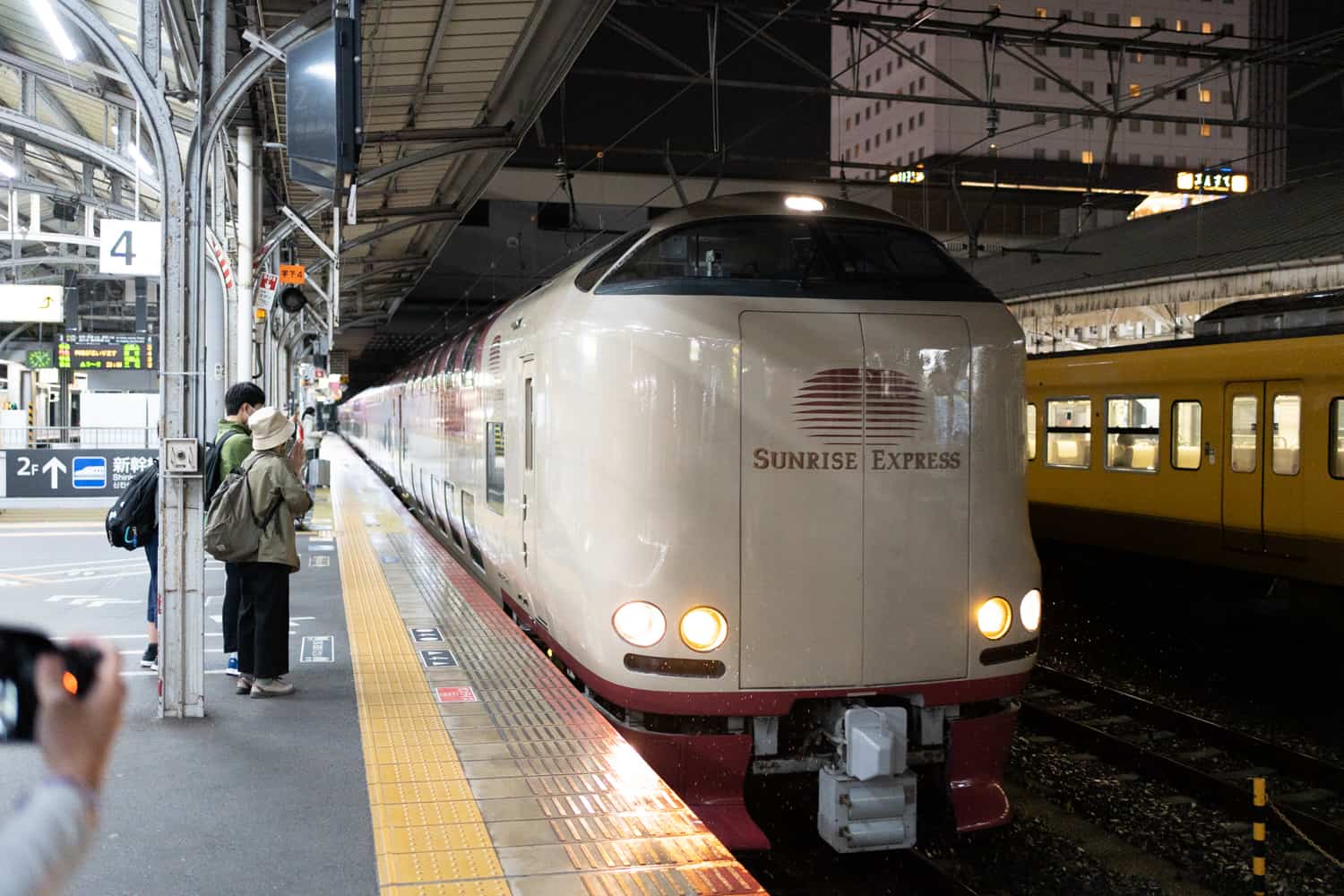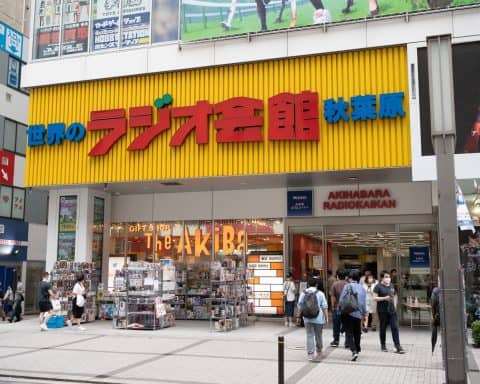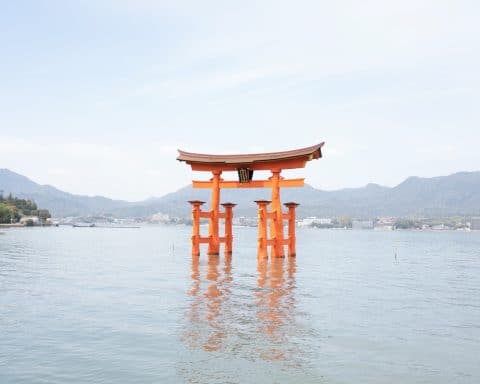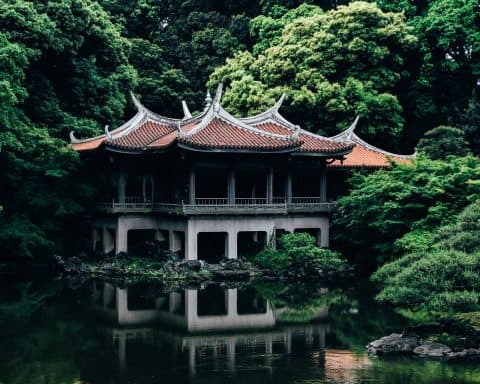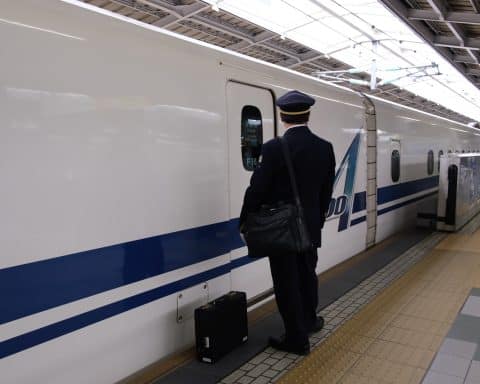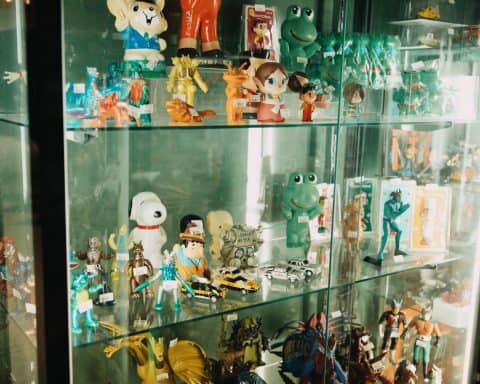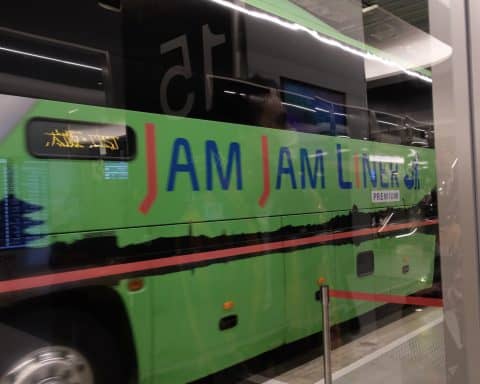Ever since I visited Japan for the first time, I was acutely aware of the country’s unique relationship with trains. High-speed, luxurious, clean, and sometimes designed for no other reason than to just enjoy the ride, there’s no wonder people travel from across the globe to experience perhaps the best railway system in the entire world.
Today we’re going to be looking at one specific train, the Sunrise Express. This is the last regular sleeper train in Japan, and it’s fair to say I’ve ticked off a bucket list item by riding on it!
For reference, each of these tips and things to know before riding the train will be in reference to the nobi nobi seat (we’ll talk about what that is later). While it’s not relevant to everything in the article, it’s the seat I’ve personally experienced which means I can give you the most honest and trustworthy information on it. Let’s get going!
1. Tickets sell out, fast
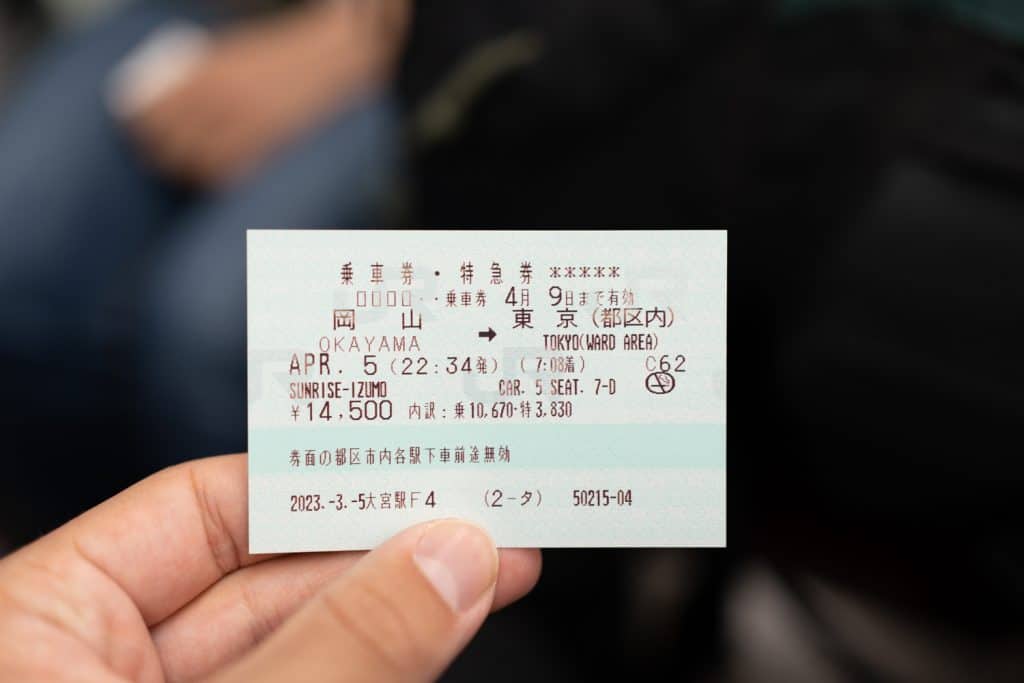
Both the Sunrise-Izumo and the Sunrise-Seto are incredibly popular services. I’ll go into a little more detail about this in the FAQ section at the bottom of the page about how to grab tickets, but all you need to know is planning will be your best friend here.
For example, my ticket above was for the Sunrise Izumo train from Okayama to Tokyo on the 5th of April. I booked that on the 5th of March!
If you’ve got your heart set on going on this Japan night train, you’re going to need to plan a few things in advance. Don’t worry, I’ve got you covered in the frequently asked questions section after these tips!
Tip: You can keep your ticket on the other side if you speak to the ticket office (next to any barriers in the train station) instead of putting it through the gate as you would usually do. I don’t know if anyone is as nerdy as me in this respect, but the ticket is pretty cool and well worth keeping if you enjoyed yourself!
2. The Nobi Nobi Seat is enough, probably…
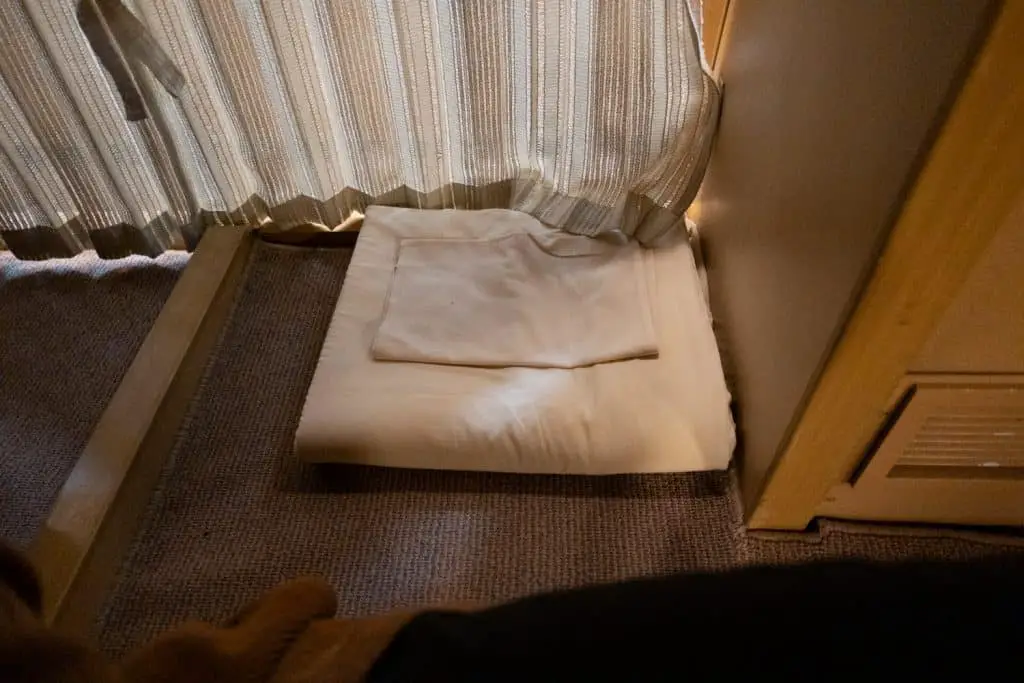
Japan comes with a lot of expensive forms of travel, and for what you’re getting, the sleeper train can work out incredibly good value for money. On this Okayama to Tokyo sleeper train, I opted for the nobi nobi seat which is the most basic, and at ¥14,500 ($108.94) it’s also the cheapest.
As far as I’m aware, “nobi nobi” roughly translates to stretching, or body waking up (Correct me in the comments!). I’ve been on a sleeper bus to Osaka before, and this experience was exponentially better. It’s a little hard, but you get a duvet (or extra back padding if you get too hot) and what I think was a pillow cover but I’m not entirely sure. In any case, it’s surreal to see the world pass by when you’re tucked up all comfy in bed. I love it!
You’ll see from the rest of this article that I absolutely think it’s worth the money, and for people on a tighter budget that still want to ride on the Sunrise Seto or Sunrise Izumo sleeper train, there’s really is no need to upgrade to the other seats.
3. The announcements are fairly quiet

I’ve been on a sleeper train in China before and although I really enjoyed that experience for many different reasons to this one, I didn’t get much sleep. One of the biggest reasons for that lack of sleep was the incredibly loud voice over the tannoy system on the train announcing what the next stop was.
If you couldn’t speak Chinese (as I can’t), the conductor would come around and let you know it was your stop next. I think he marked it down when he checked our tickets as we got on. In any case, it was a nice safety net!
The Japan sleeper train was slightly different. I don’t know if it was out of respect for the passengers or just because the speaker system wasn’t that loud, but I could barely hear anything. I don’t know Japanese fluently, but I know the word ‘Tokyo’ and I don’t think I heard it spoken once over the speakers.
So if you’re waiting for your stop to be mentioned, make sure you’ve double-checked the time you’re supposed to arrive so you can pack your belongings beforehand. Part of me was expecting someone to come around and let us know what the next stop was, but perhaps I’m just being fussy.
4. It makes sense to board before Osaka

One of the big benefits of getting a sleeper train in Japan is… to sleep. I’m not saying you can’t do that if you get on in Osaka, but it’ll certainly be more of a challenge.
We got the train from Okayama at just after 22:30 which gave us the entire day to fill with fun activities (Planned to go to Okunoshima Island but the rain kept us away… boo!) and then more than enough time to have dinner and explore BIC Camera for the 1 millionth time.
After about an hour or so on board, my excitement levels had calmed down a little and I was able to get to sleep before midnight and arrive feeling fairly refreshed. If we had chosen to board at a later stop like Osaka or closer, the boarding time would have been past midnight and any potential benefit of sleep may have been lost due to the tiring day and late night.
The beauty of this kind of transport is that you’re moving and sleeping at the same time which drastically saves time and money, so you might as well make the most of it if your itinerary allows!
5. You can reserve a ‘nobi nobi’ seat if you have the JR Pass

If you’re coming to Japan for a holiday, you’ll have the chance to purchase a JR Pass. Depending on your intended itinerary and train usage, this can save you a lot of money. As well as being able to use normal trains, you’ll have access to ferries and, most importantly, this sleeper train for no extra cost.
I haven’t written an article about the JR Pass because I’m not eligible to buy one, so take a look at JPRail for a fairly detailed guide on how to go about it. If you’ve decided to get one (use this calculator to figure out if it’s worth it), you can use the same website to reserve a space on the Sunrise Izumo and Sunrise Seto up to 1 month beforehand. Unless you’ve got a friend already in Japan, this is likely your best bet to secure a spot on the train due to its popularity.
I’ll tell you how to sunrise Izumo booking at a train station in Japan later on in the article, but unless you’re traveling during the low season, you may need a backup plan.
6. It’s wobbly, to say the least
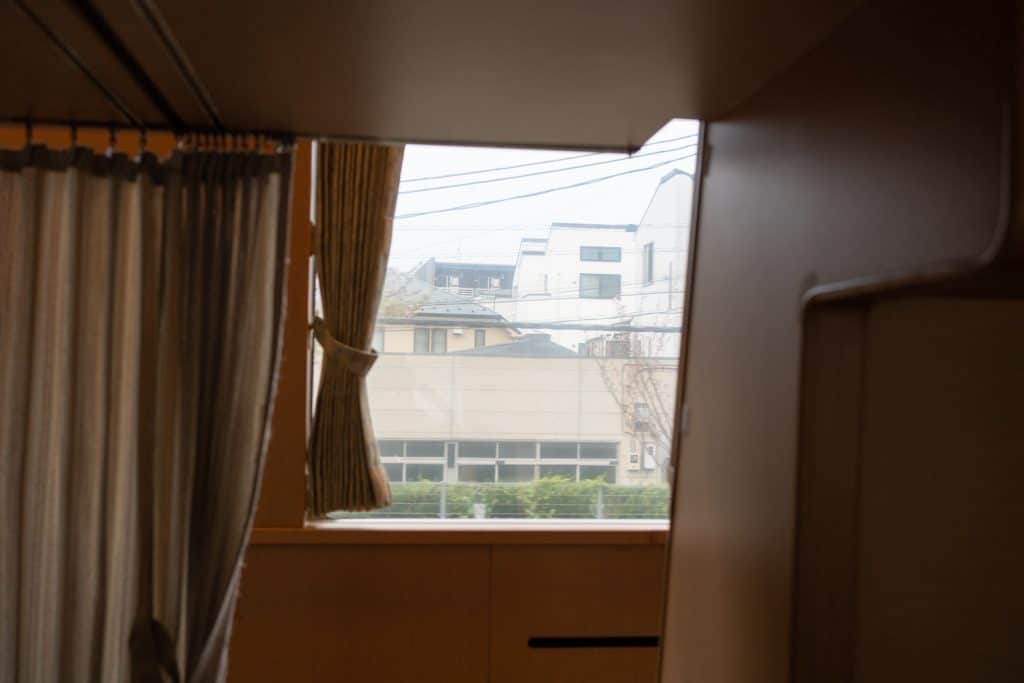
While the wobbly motion of the train was quite relaxing to me, it was more than noticeable and may be an issue if that’s likely to keep you awake. If you decide to get dressed into your pajamas and those pajamas happen to be silk, it’ll be like you’re on a dry slip n slide. Good luck!
As the train tends to move from side to side quite a bit, watch out when you’re walking to the toilets. One tight bend could be the difference between comfortably walking down the car and ending up in a random person’s bed at 3 am.
7. The basic seats are incredibly spacious
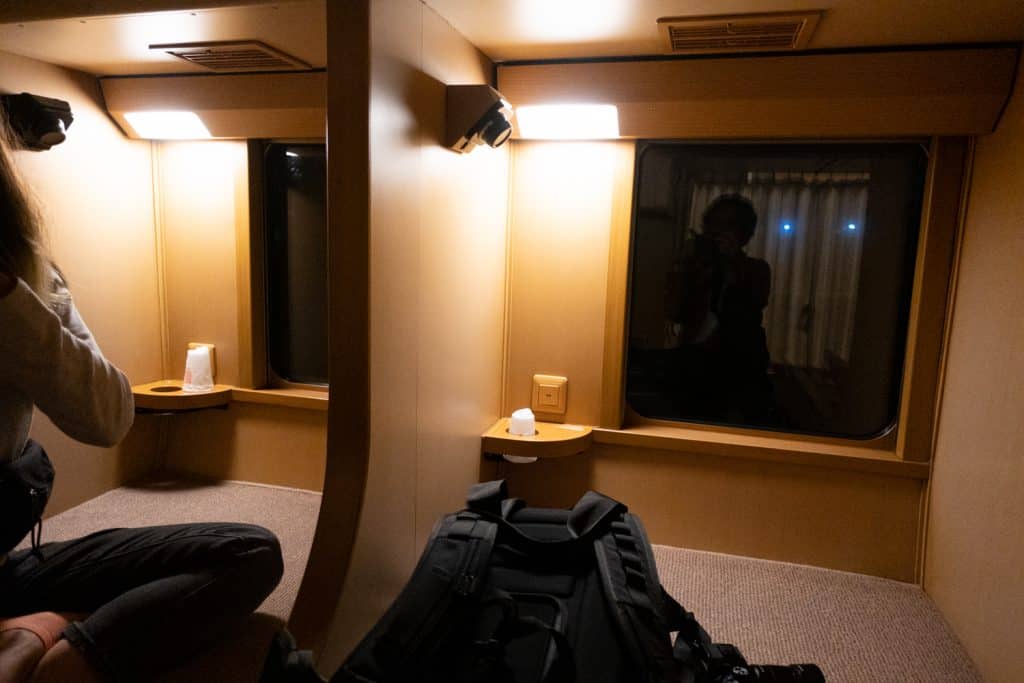
Though there is no room to store your luggage in a separate space, there’s still more than enough room to sleep comfortably. I’m 6ft, and I could easily sit up, work, and move around without feeling cramped like I have done on other sleeper trains in the past.
Early in the morning when the sun is just peaking over the horizon, leaning your back up against the wall and resting your feet on the other side is perfectly comfortable. In fact, I had so much space that I slept with both my own and my partner’s luggage without any feeling of being in a tight space.
The room also comes with a paper cup for you to fill up with water in the washrooms (different areas from the toilets), a reading light, and a fan. If it’s too light outside when the train stops at the station, you can pull down your blackout blind for a bit of shut-eye.
8. The luxury rooms come with pajamas
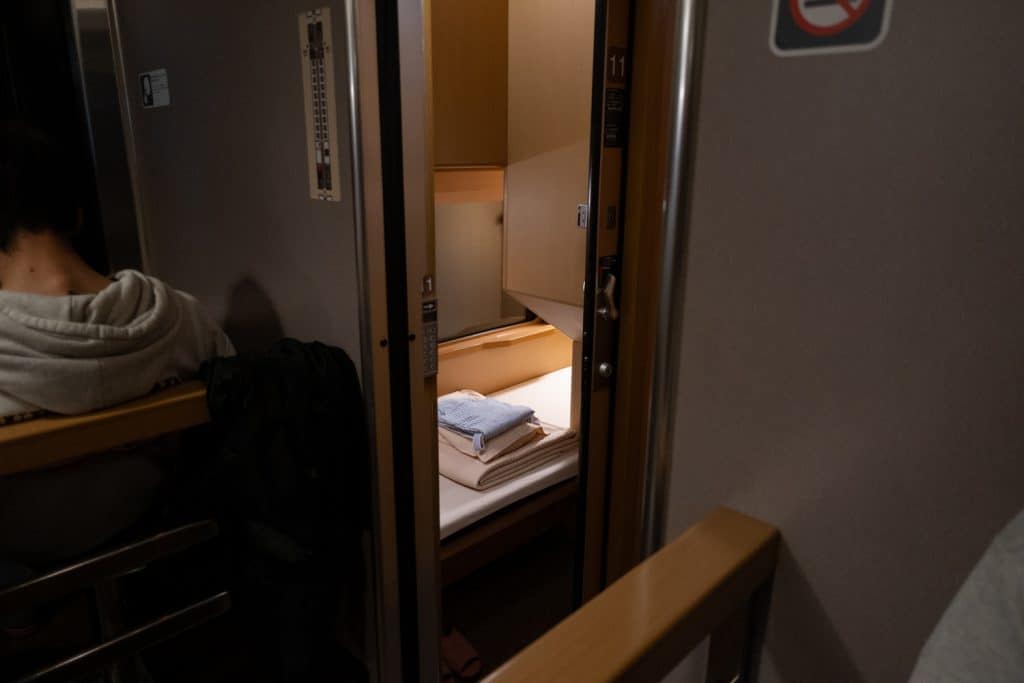
I mean, I don’t feel like this would be the reason for me choosing a luxury room over the standard nobi nobi seat, but this is so typically Japanese. In every single hotel we’ve been to (including the most budget), we’ve been given pajamas to wear. Just another incentive to follow along with Japan’s culture of ‘hands-free travel’.
Another benefit of the single bedrooms is that the bed is facing forwards. With the extent of the rocking likely to be a problem for light sleepers, facing forward might be a way to negate some of the effects. Unfortunately, these benefits come with a steeper price point which isn’t ideal for the average traveler and may make the inclusion of transport and accommodation in one price start to lose its value.
9. It’s warm
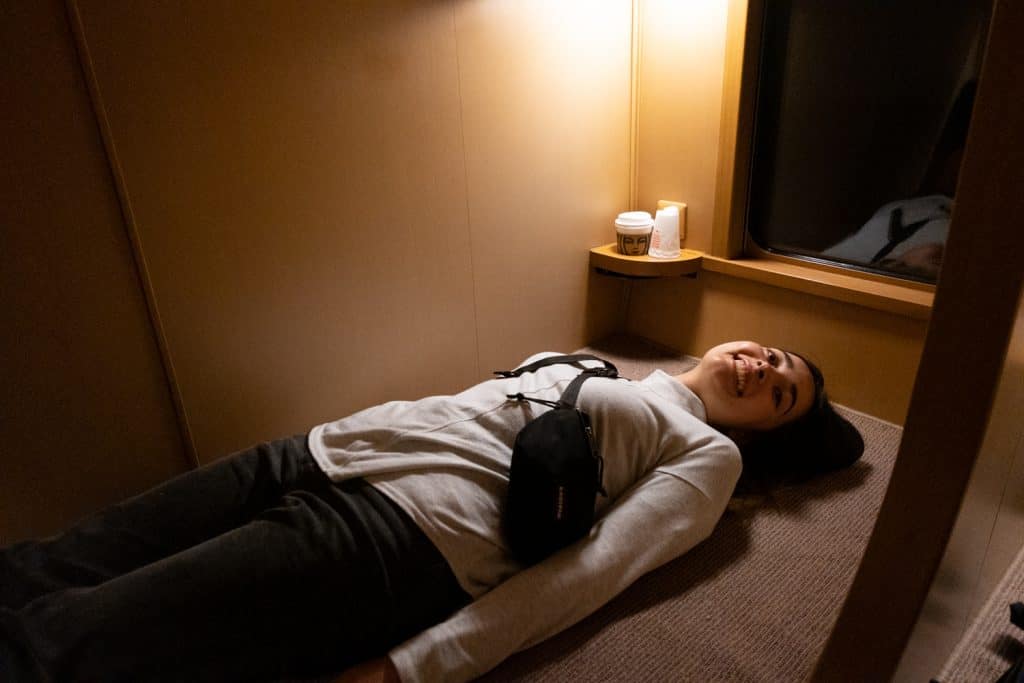
Despite what I’ve read about the Sunrise Izumo night train in Japan, I found the whole thing to be on the hot side, rather than cold. Perhaps that’s due to the time of year I went, but either way, it still pays to be prepared for both scenarios.
If you do end up getting a bit hot, you can always use the extra layers to make a pillow if you’re sleeping in the nobi nobi seat! You’ll also have an air conditioner directly above your head which does its part to keep you cool. Just turn it off if it’s too much. If you’re worried about getting dry skin on the journey, which was also a concern of mine, take a look at these Japanese skincare brands before you go.
10. There are no food options
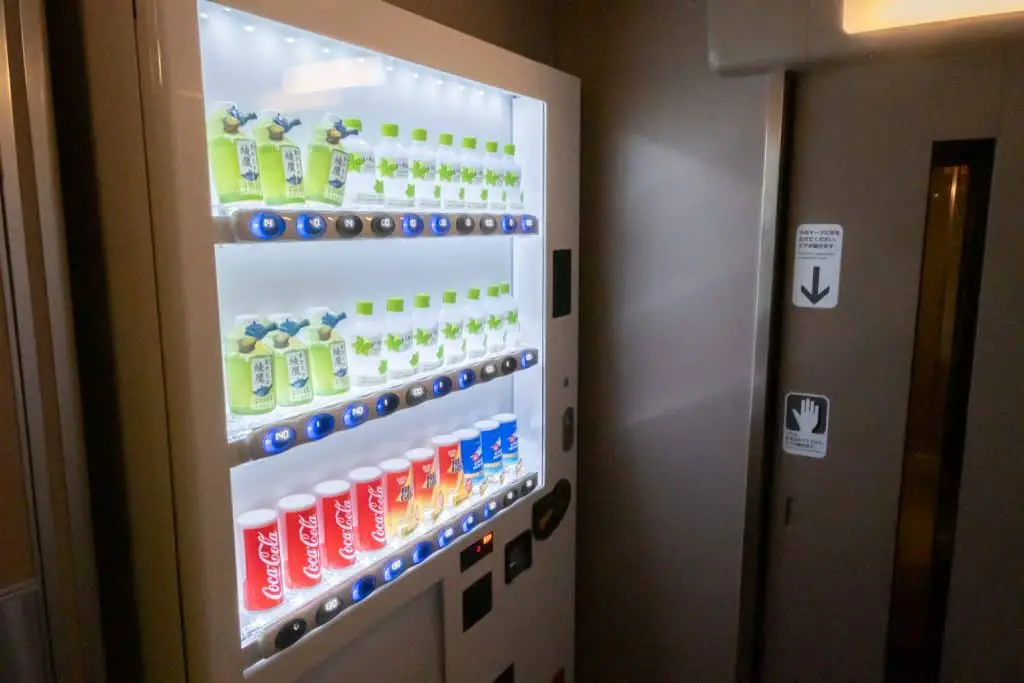
There are no food options available on the train, so prepare accordingly beforehand. On a bullet train that would usually mean grabbing a bento box, but because the Sunrise sleeper train arrives on an ordinary platform, that’s not going to be so easy. Okayama station has a number of food options in the connected food hall, and plenty more around the town.
We grabbed a bite to eat in the city and then stocked up on food from the local konbini. It was mainly sweets as we wanted to be as respectful as possible to our fellow passengers… and we love Japanese snacks! When we arrived in Tokyo, we had breakfast at a damn pretty Starbucks, and then lunch later at Gonpachi in Nishiazabu.
11. You can have a 30-minute shower for ¥1,000
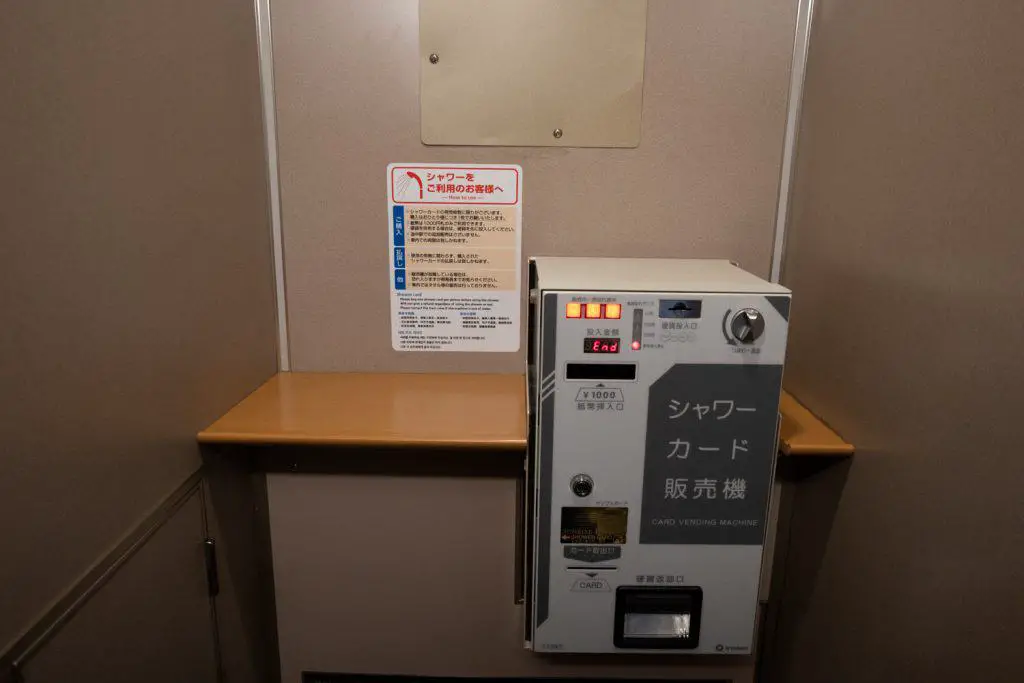
Traveling is a sweaty business at the best of times, so it’s awesome to see shower facilities on the overnight train in Japan. For just ¥1000 ($7.51) you get access to the shower for 30 minutes. I honestly can’t remember the last time I took 30 minutes in the shower, but other than a massive waste of water, it seems nice and relaxing.
If you’ve got somewhere special to be in the morning or you just like the idea of feeling clean before you disembark, paying just over 7 dollars seems like a great deal. I didn’t do it on our journey so I don’t have any photos of the shower, but knowing Japan as intimately as I do, I would be shocked if it’s anything less than immaculate.
12. Bring your eye mask

The big complaint that two of the four people I was traveling with on the Sunrise Izumo had, was the light pollution. Above is a picture of the bottom row of beds and you can see just how bright the light is. Other people frequently make reference to how you get no privacy in the ‘nobi nobi’ seats (Thanks to a massive wooden separator, I disagree), but the bigger problem is actually the lighting.
I slept on the bottom row, but the top row is slightly worse because of the direct eye line with the lights. If you struggle to get to sleep with the lights on (and they’ll stay on all night), do yourself a favor and pick up a sleep mask beforehand!
13. There’s a viewing deck
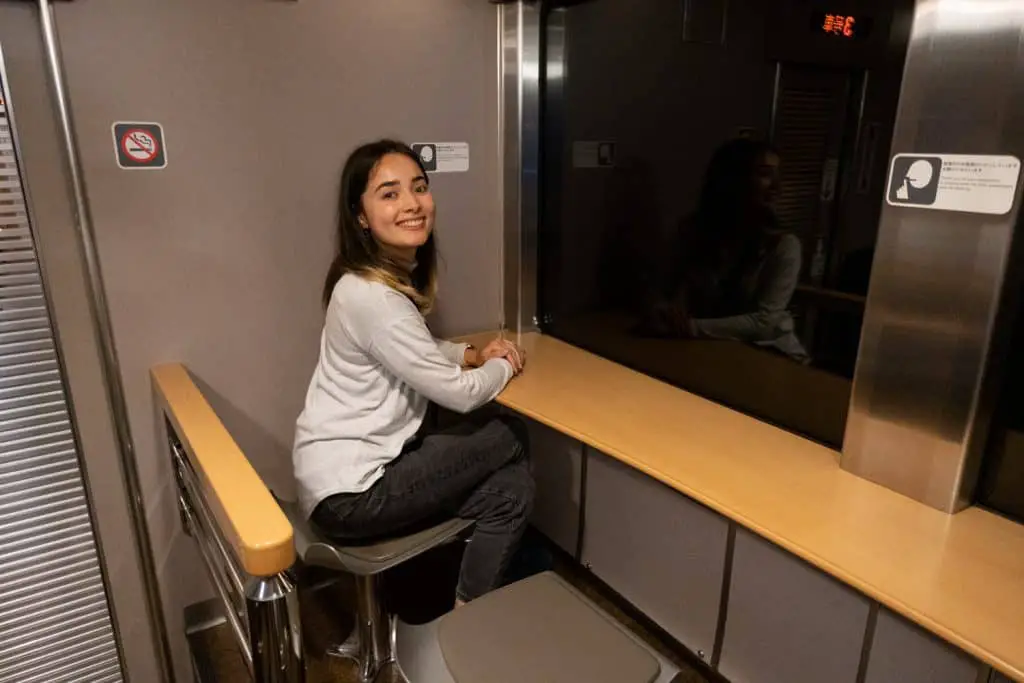
Unfortunately, I didn’t get to take advantage of this space because I was fast asleep until about 10 minutes before our stop, but the Izumo sleeper train in Japan does have a viewing area. It features absolutely giant windows and is the perfect place to view the sunrise if you can bother to get up.
Unfortunately, just like the ‘nobi nobi’ seats, it doesn’t have any power outlets. That’s a really important thing to remember if you’ve booked into the standard seats, so plan your day after accordingly and bring a portable charger if you have one.
FAQs about the Sunrise Izumo
What is the difference between Sunrise Seto and Sunrise Izumo?
The Sunrise Seto ends in Takamatsu (that’s all the way on the island of Shikoku!) and the Sunrise Izumo goes to Izumo on the top side of Japan. However, if you’re catching the train anywhere from Okayama to Tokyo, it’ll be exactly the same train.
That’s because both trains join together in Okayama just before its 22:30 departure time. Yet another nerdy moment for me, and apparently a lot of other people!
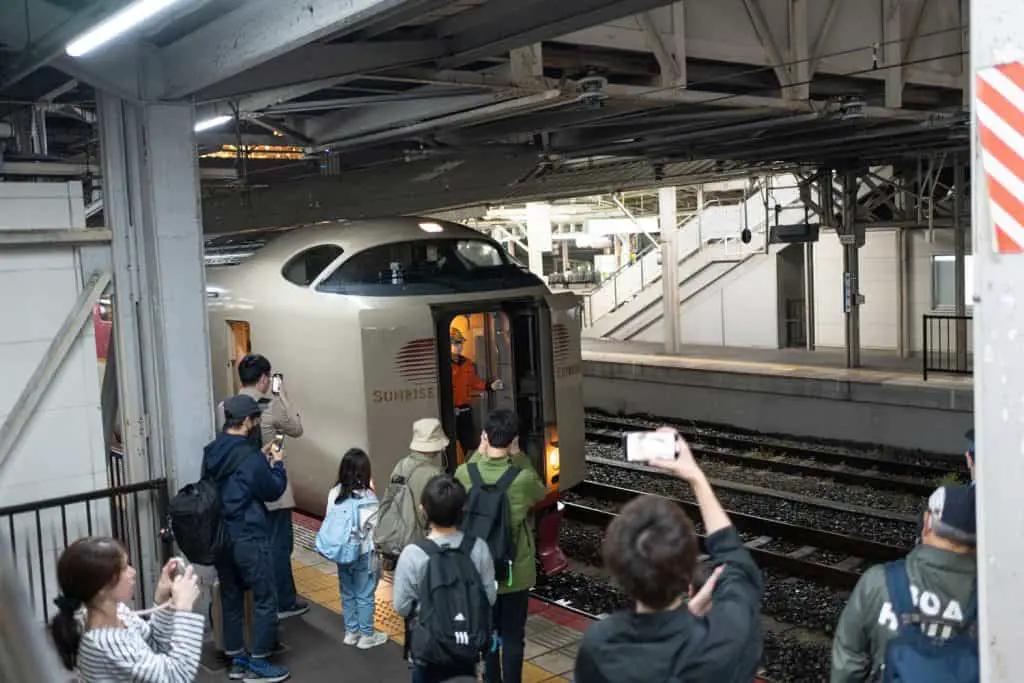
The Sunrise Seto and the Sunrise Izumo sleeper trains become one, ready to make their trip up to Tokyo. On the way back, the train splits at Okayama and they go up to their respective destinations. I took a video too, but I’m not sure anyone else cares enough for me to post it!
Why is the Sunrise Izumo so popular?
Both of these overnight trains are Japan’s last regularly scheduled sleepers. While the country has a few, incredibly expensive alternatives, getting tickets is even harder and completely out of reach for a lot of people.
Almost all of the other trains have been decommissioned because of the introduction of the faster bullet trains, and it wouldn’t surprise me if the Sunrise Izumo and Sunrise Seto Japan sleeper trains were next to go.
When, or if, that will be I don’t know.
But it was my goal to ride it at least once, just in case that day came sooner rather than later.
How do I reserve Sunrise Izumo?
So we’ve already talked briefly about how to reserve tickets if you’ve got a JR Pass, but what about if you want a more luxury seat or haven’t bought the pass?
In that case, you (or someone already in Japan) will have to make your way to a ‘Midori no Madoguchi’. The Midori no Madoguchi (green window) which I’ve annoyingly forgotten to take a picture of, is basically a big ticket office for any train tickets you want to book. Shinkansen, special trains, that kind of thing. You’ll find one in almost all large stations, and it will be immediately recognizable because of its bright green banner.
In case you can’t read Japanese, it will likely say “Ticket Office” or “JR Ticket Office” and have a green picture of a person sitting on a chair facing to the left-hand side.
Once you get in there, ideally as soon as your day’s ticket comes on sale (10 am, up to one month before), just use google translate, point at pictures, and make sure you book for the right dates and stations.
My partner speaks Japanese so it was an easy process for us, but we could still point at the screen to confirm the seats we wanted. Plus, Japanese people on the whole seem to go above and beyond the call of duty to make sure you’re happy and satisfied with the service. That really helps when there’s a language barrier.
What platform is the Sunrise Izumo in Okayama?

Unfortunately, the platform of the Sunrise Izumo wasn’t special or well signalled. We wanted to be on the platform well before it arrived so we asked around and finally figured out it was on platform 4. I’m not entirely sure if it’s always on this platform in Okayama so make sure to double check, but this is where it turned up for us anyway.
What is the Sunrise Izumo Schedule?
| Station | Towards Izumo | Station | Towards Tokyo |
| Tokyo | 22:00 | Izumoshi | 18:51 |
| Yokohama | 22:24 | Shinji | 19:06 |
| Atami | 23:23 | Matsue | 19:27 |
| Numazu | 23:40 | Yasugi | 19:45 |
| Fuji | 23:54 | Yonago | 19:56 |
| Shizuoka | 0:20 | Niimi | 21:20 |
| Hamamatsu | 1:12 | Bitchu-Takahashi | 21:48 |
| Osaka | – | Kurashiki | 22:14 |
| Sannomiya | – | Okayama | 22:34 |
| Himeji | 5:25 | Himeji | 23:55 |
| Kurashiki | 6:46 | Sannomiya | 0:13 |
| Bitchu-Takahashi | 7:14 | Osaka | 0:34 |
| Niimi | 7:43 | Hamamatsu | – |
| Yonago | 9:03 | Shizuoka | 4:38 |
| Yasugi | 9:13 | Fuji | 5:09 |
| Matsue | 9:30 | Numazu | 5:26 |
| Shinji | 9:45 | Atami | 5:43 |
| Izumoshi | 9:58 | Yokohama | 6:44 |
| – | – | Tokyo | 7:03 |
Remember to double-check this because it has the chance to be changed at any time, especially if there are delays on the day. However, hopefully, it’ll help if you’re looking to plan your previous or preceding day to the Izumo night train in Japan.
The Sunrise Seto has a different schedule of course, but I’ll leave that for another time.
How much is the Sunrise Izumo?
If you’re happy with the ‘nobi nobi’ seat, and you have a JR Pass, it’s completely free. Unfortunately, that’s one of the main reasons it’s so popular. If you haven’t purchased a JR Pass like me, the sunrise Izumo price is ¥14,500 ($108.94) to get from Okayama to Tokyo. Remember, that’s for accommodation and transport.
Take it from me, it’s the best way to travel between the two cities. Completely forget about night bus travel unless you love sleepless nights or you’re on your last ¥10,000. It’s hassle-free, a memorable experience, and honestly quite comfy.
Is the Sunrise Izumo worth it?
For me? The Sunrise Izumo sleeper train in Japan was 100% worth it. So much so, that I’ll probably book it again if I head down that way. However, there are a few reasons why you may choose to take an alternative method of transport.
If you’re coming from my 2-day Hiroshima Itinerary and you don’t have that much time, the bullet train may be the better decision. No matter how much I enjoyed this Japanese sleeper train, it can’t get you back to Tokyo in under 4 hours.
At just under ¥20,000 ($150) the Shinkansen is technically only a little more expensive than the Izumo, so I totally understand why you’d pick it if you needed to. Plus, traveling by bullet train is, obviously, my all-time favorite way of getting around in Japan. Once you’ve done it once, you’ll struggle to travel on any other mode of transport again.
However, if you fancy an adventure, are happy to have one of your nights included in the ticket price, and up for a memory of a lifetime, the Izumo Sunrise is one of the best things to do in Japan. The standard nobi nobi seat is more than adequate for most people if you can reserve it, but if you’d prefer something a little more swanky or you like the idea of a private compartment, there are plenty of options.
Let me know if you travel in one of them, and make sure to send me all the pictures! Throw any questions you have about this Japan sleeper train into the comments and I’ll answer them asap!



